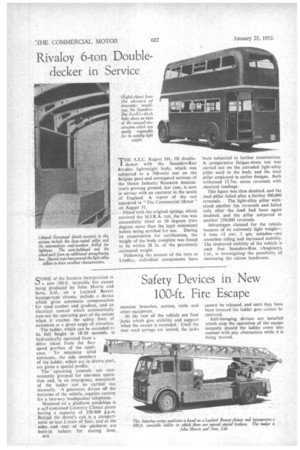Rivaloy 6-ton Double decker in Service
Page 50

If you've noticed an error in this article please click here to report it so we can fix it.
SOME of the features incorporated in a new 100-ft. turntable fire escape being produced by John Morris and Sons, Ltd., on a Leyland Beaver haulage-type chassis, include a device which gives automatic compensation for road camber and gradient, and an electrical control which automatically cuts out the operating gear of the escape when it reaches the safety limit of extension at a given angle of elevation.
The ladder, which can be extended to its full height in 18-20 seconds, is hydraulically operated from a 'drive taken from the fivespeed gearbox of the appliance. ' To minimize wind resistance, the side members of the ladder, which are in drawn steel, are given a special profile.
The operating controls are conveniently grouped for one-man operation. and, in an emergency, movement of the ladder can be carried out manually. A generator, driven off the batteries of the vehicle, supplies current for a two-way loudspeaker telephone.
Mounted on a platform amidships is a self-contained Coventry Climax pump having a. capacity of 350.500 g.p.m. .Behind the . driver's cab, is a, compartment to seat Is crew of four, and at the sides and rear of the platform are
lcckers for storing hose,
T1-1E A.E.C. Regent Mk. 111 doubledecker With the Saunders-Roe Rivaloy lightweight body, which was subjected to a 500-mile test on the Belgian pave and corrugated sections of the Motor Industry Research Association's proving ground, last year, is now in service with an operator in the south of England. A report of the test appeared in "The Commercial Motor" on August 31.
• Fitted with the original springs, which survived the M.I.R.A. test, the bus was successfully tilted to 30 degrees (two degrees more than the legal minimum) before being certified for use. During its examination for certification, the weight of the body complete was found to be within 28 lb. of the previously estimated weight.
Following the success of the tests at Lindley, individual components have been subjected to further examination. A comparative fatigue-stress test was carried out on the extruded light-alloy pillar used in the body and the steel pillar employed in earlier designs. Both withstood 13.7m. stress reversals with identical loadings.
This figure was then doubled, and the steel pillar failed after a further 300,000
reversals. The light-alloy pillar withstood another 1m. reversals and failed only after the load had been again doubled, and the pillar subjected to another 250,000 reversals.
Advantages claimed for the vehicle because of its extremely light weight—
tons 15 cwt. 3 qrs. unladen—are smoother riding and increased stability. The improved stability of the vehicle is such that Saunders-Roe (Anglesey), Ltd., is investigating the possibility of increasing the saloon headroom.




















































































